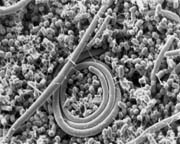
Donald C. Lay, research leader at the US Agricultural Research Service, and Scott T. Willard of Mississippi State University, have shown they can treat bacteria to give off light, making it possible to track infections in living piglets and through tissues of adult pigs after slaughter. Their goal is to adapt the technique so cameras can see through the denser mass of live, 250-pound, market-ready pigs. The team will research ways to improve swine management by identifying animals that are more susceptible to infection and design techniques to prevent those swine from spreading infection to their herd mates.
Certain swine seem prone to shedding Salmonella bacteria in manure when stressed by the transport and mixing with different herds that is associated with going to market. Scientists don't know how bacteria migrate through an animal's body, including where they might "hide" and what causes them to be suddenly shed. These gaps are largely due to an inability to follow the progression of infection in live animals.
Willard and Lay hope to photograph a salmonella infection as it moves through a live pig and show the process as patches of colors. Willard is an expert in biophotonics, a new technology that uses light to mark molecular changes.
For additional information visit www.ars.usda.gov.

